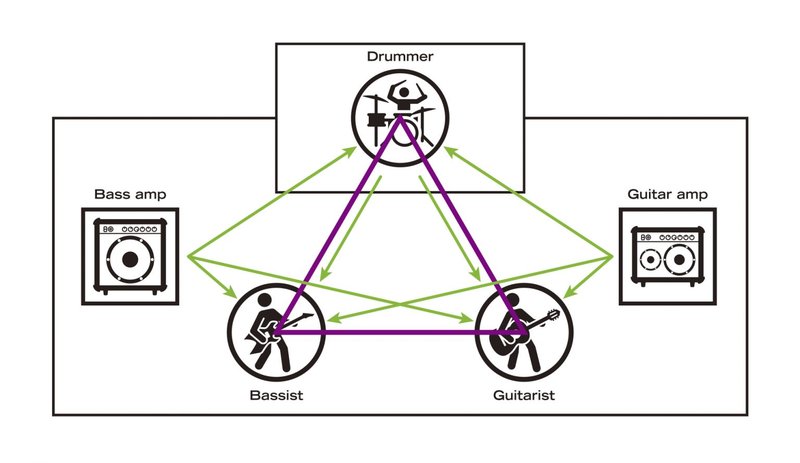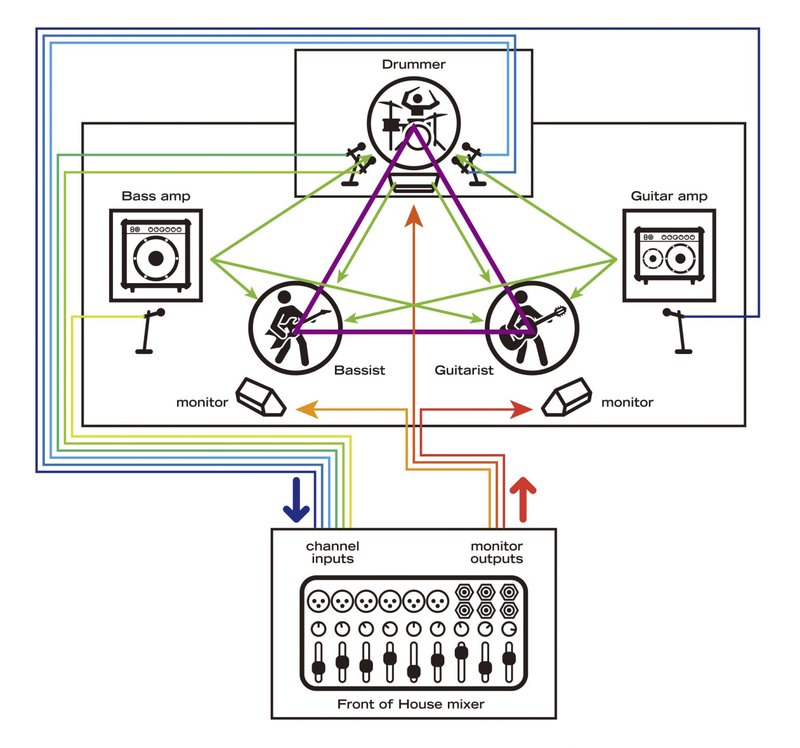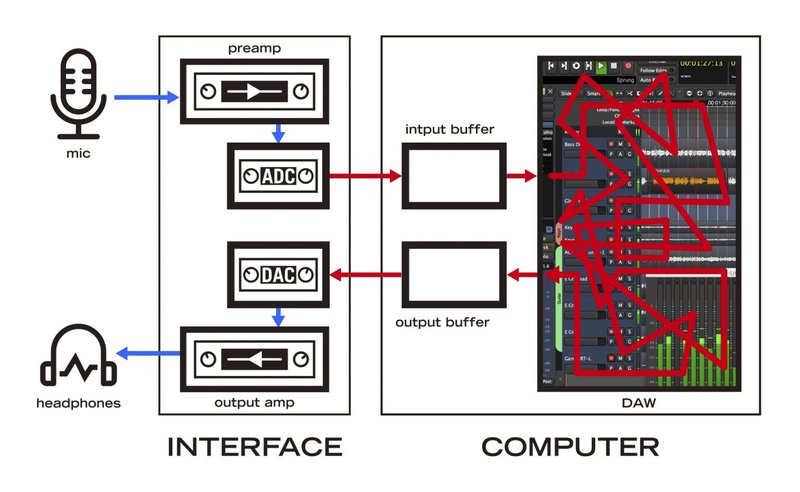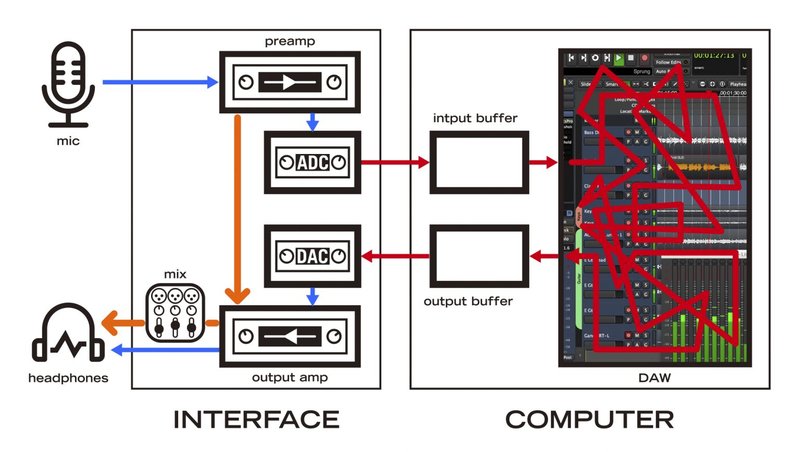Improve Your Performances With Direct Monitoring
When you look at the specs for an audio interface or USB microphone, you will often see the term direct monitoring. It’s reasonable to assume that direct monitoring is a good thing, but what does it do and how does it work?
In this article, we’ll explain why direct monitoring is vital for your digital recording sessions – by explaining the serious problem that it solves.
Time delay
The entire subject of direct monitoring revolves around latency – the time delay that audio encounters when going from the analog world to the digital world and back again. Understanding this time delay is critical because of how we, as musicians perceive it.
The human ear is fantastically sensitive. Under the right circumstances, we can detect a time delay of under 1 ms (1 millisecond, or 1/1000 of a second), and delays of even a few ms can be felt when we are playing.
Now, audio travels at the speed of sound – not a very surprising fact, if you stop to think about it – which roughly translates to 1 foot per ms. When you play an acoustic instrument, the distance to your ears is so small that you hear the sound right away. However, when the distance gets longer, things get complicated.
Imagine that you’re the guitarist in a band on a decent-sized stage, with no microphones or mixer in the room. You’re on one side of the stage and you have your guitar amp about 5 feet away; the bassist is on the other side of the stage, about 20 feet away from you, with his bass amp 5 feet farther away from him. The drummer is on a riser about 20 feet above and behind you, center stage.

Now, with all three of you 20 feet (20 ms) apart, you would think that your time delays would all be equal, right? They’re not.
First of all, your guitar sound doesn’t come from you, it comes from your amp, and the same is true for the bassist. Your distance to the drummer matches the bassist’s, but all the other distances – between you and your amp, or you and the other amp – are different from one another. Even more importantly, your bandmates are reacting to the notes you played several milliseconds ago, while you’re reacting to what they played several ms ago – on a big enough stage, your timing will fall apart.
Electricity to the rescue
This is where mics and a mixer come in handy. Electrical signals travel at effectively the speed of light, adding no time delay at all, and that helps us get to a musical performance that sounds and feels good.
Imagine that same band setup, but now every sound source is mic’d and all signals are being fed to the Front of House mixer, where the engineer sends back a monitor mix to all the musicians.

Because the mics are close to the drums or amps (no delay) and the signals travel to and from the mixer at lightspeed, all of the instruments are heard and mixed at the same time, no matter how far away they are from each other, and sent back to the musicians at effectively the same moment they’re played.
So if you and your bandmates have stage monitor wedges like the Samson RSXM10A or RSXM12A close to you, you’ll hear a signal that’s close enough to minimize any time delay – and line up all of your bandmates’ audio in time so you’re all playing together. In effect, the mics and mixer and monitors give audio a ‘shortcut’ around the laws of acoustics.
In this situation, we end up with time delays that are anywhere from tiny to non-existent, so they don’t affect our timing and playing. We call this near-zero or zero latency. However, as the old saying goes: To err is human, but to really mess things up, add a computer!
Here comes latency
As you may know, the digital recording process requires analog-to-digital converters (ADCs or simply A/D) and digital-to-analog converters (DACs or D/A), which sample your audio at very high frequencies and turn it into digital data for your computer to work with, then turn it back into audio for you to listen to. Conversion adds a tiny amount of latency… but that’s only the first step on our journey.
Your audio is now in your computer – but to make sure your software receives audio in a nice steady stream without interruptions, it’s sent through a holding area called an input buffer, which adds latency based on its size. Really small buffers work your computer much harder and have a high risk of dropouts, clicks, and pops, while larger buffers are more reliable but add much more latency.
Now your digital audio finally gets to play with your software! The most common type of audio program you’ll encounter is a digital audio workstation or DAW. You can think of a DAW as a recording studio inside your computer; it lets you record audio tracks, process them with effects (called plug-ins), edit them, and mix them into completed songs. There are many different DAWs out there, for all kinds of computers and tablets. Some are simpler, others more elaborate; some are more costly, others quite affordable – or even free, like Audacity and GarageBand.
Audio operations inside a DAW – such as recording, mixing, editing, and adding effects – all add different amounts of latency. Audio channels that end up out of sync because of these differences are brought back into line by delaying the faster ones to match the slowest, which adds more latency. Then the audio is fed back to the DAC (digital to analog converter), which is kept running smoothly thanks to an output buffer that adds even more latency.

Put this all together, and you have a significant, easily audible time delay from the moment you pluck a string on your guitar to the moment you hear the processed signal coming back from your computer. This time delay will be more than enough to throw off your playing and make your performance stilted and sloppy; to hear the effect, try to play an instrument or sing while listening to yourself with a slapback delay and no dry signal. Ouch!
Direct monitoring: electricity to the rescue (again)
Fortunately, there’s a way to get our trusty helper electricity back in the game, and that’s with direct monitoring. I’ve given you a hint above – you have trouble playing along with a delayed signal, if there’s no dry signal. But what if there is?
All of the problems and solutions we’ve talked about now come together neatly in one thing: a circuit inside your interface that grabs the signal coming in – and immediately turns it around before it gets to the converters and shoots it right back out again, back to your ears. In the same way that our mixer and stage monitors let us bypass acoustic time delay, this direct monitoring circuit lets us bypass digital latency.

Now, unless the interface has effects built in, that direct signal is unprocessed and dry. This isn’t terribly inspiring to a vocalist who likes to hear their voice with reverb or chorus, or a guitarist having to do without their digital overdrive, echo, and so on. However, direct monitoring has one more trick up its sleeve – it feeds your headphones a mix of the clean direct sound and the processed sound coming back from your computer.
For example, when you play guitar into your Samson G-Track Pro’s Instrument input, you’ll hear the clean attack of each note right away, followed by the fully processed sound after a short delay. The attack helps you keep time, and the prettied-up sound follows along quickly enough to inspire you.
Some USB mics, like the Samson Q9U XLR/USB Broadcast Dynamic Microphone, always provide a mix of direct and computer signals in their headphone outputs; others, like the G-Track Pro and Satellite, have a Monitor switch that lets you turn off the direct signal in case you do want to listen to the computer audio on its own.
You’ll want to play with the amount of signal coming back from your DAW to balance it against the direct signal. It can take surprisingly little direct signal to focus the brain on what’s important, or you may find that you prefer to go entirely dry; just see what feels right to you, because if it feels right, it is right.
Line it up!
Whether you’re recording spoken word, vocals, or instruments, direct monitoring will help you perform at your very best. Have fun, and remember: in good recording practice, there are no shortcuts – except in direct monitoring.
